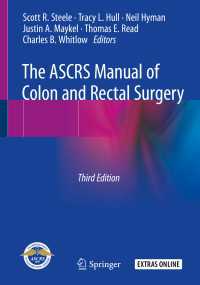Full Description
The genomic era encompasses the entire spectrum of DNA—all of the genes and the interaction and interrelationship of genes (genome) to the environment. Rapidly changing research has led to numerous advances in genetic testing, diagnosis, and treatments, and it is essential that APRNs are able to integrate genetic risk assessment into clinical care. This quick reference delivers complex information in an easy-to-read, step-by-step format with bitesize info boxes and bulleted lists to provide the tools necessary to understand genetics/genomics and identify "red flags" that can appear in patient assessments.
In an age of personalized and precision medicine, genetic risk assessment has never been more important. Genetics and Genomics in Nursing begins with an overview of genetics and the science behind inheritance. Chapters then break down the processes that make up risk assessment and walk the reader through data collection and review, identification and calculation of risk, and patient communication. The last section of the text discusses special populations and key facts nurses need to know about their risk assessment.
Key Features:
Provides a clear introduction to a complex topic
Describes important elements of the genomic risk assessment process for use in clinical settings when evaluating patients
Illustrates how to develop a three-generation pedigree
Applies commonly used standardized pedigree symbols and familial patterns to aid in risk interpretation
Discusses the challenges and limitations of pedigree interpretation
Explains common concepts and includes helpful genomic resources
Incorporates genomic risk assessment into patient evaluation
Contents
Contents
Contributors
Preface
PART I. Introduction to Genetics/Genomics
1. Risk Assessment: An Important Component of the Essential Genetic and Genomic Competencies for Nurses With Graduate Degrees
2. Overview: Genetics/Genomics
3. Patterns of Inheritance
PART II. Introduction to the Genomic Risk Assessment: A Step-by-Step Process
4. Step 1.a: Review Collected Data—Personal, Ancillary, Laboratory, and Physical Examination
5. Step 1.b: Review Collected Data—Family History and the Use and Interpretation of the Pedigree
6. Step 2: Identification of Risk—Assessment of Red Flags
7. Step 3: Selecting Risk Probability
8. Step 4: Risk Communication and Risk Management
PART III. Special Populations
9. Risk Assessment in Preconception and Maternal Care
Jill Fonda Allen, Lisa M. Freese, Quannetta T. Edwards, and Charles J. Macri
10. Newborns, Infants, and Children
Ann H. Maradiegue
11. Cancer and RISK Assessment
12. Summary
Index
-

- 電子書籍
- Motor Fan illustrat…
-

- 電子書籍
- 週刊東洋経済 2021年6月26日号 …
-

- 洋書電子書籍
- The Gospel Accordin…
-

- 洋書電子書籍
- アメリカ大腸外科学会(ASCRS)マニ…




